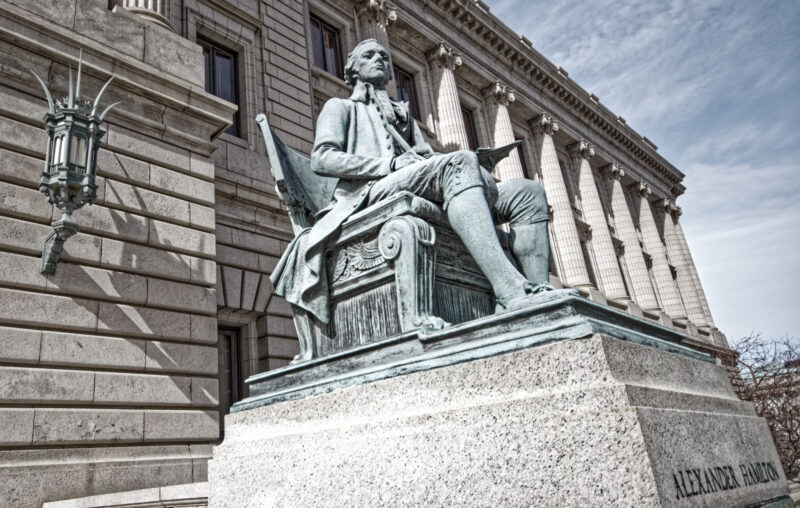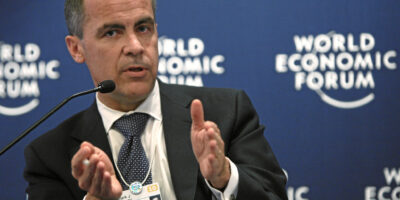Who Owns Alexander Hamilton?

Ever since Aaron Burr gut-shot Alexander Hamilton in a duel in 1804, the legacy of the most controversial Founder and Framer has been fought over by people from throughout the political spectrum. Stephen F. Knott built a career studying Hamilton’s reception by scholars and the American public over time. Some loved Hamilton, some hated him, and some wrote musicals about him, but only a handful fully understand his impact on US economic development and policy.
Most recently, National Conservatism (NatCon) pundits like Julius Krein insist that Hamilton’s Report on Manufactures called for big government in general, and protective tariffs in particular, to bolster their view that America today needs “strategic tariffs” as part of a “national industrial policy.” This attempt to capture Hamilton’s legacy, like so many others that have come before, is based on an outdated misreading of Hamilton’s Report and of the actual policies he pushed through Congress.
I and others have already explained how Hamilton did not, in fact, want a large, permanent national debt, nor just one big bank, nor a manufacturing monopoly, nor any of the heinous policy crimes of which he now stands accused. His funding system did indeed cement together the fragile new union, and he laid the groundwork for America’s subsequent corporate and legal development.
Perhaps the most important thing to understand about Alexander Hamilton today, however, is that he did not, repeat, did not, espouse massive government, militarism, or protective tariffs.
Like all the Founders and Framers, Hamilton was what is today called a classical liberal, someone who believed in what law school professor Randy E. Barnett calls the “presumption of liberty” interpretation of the US Constitution. Like James Madison and the others, Hamilton believed that the Preamble and the Ninth Amendment – that’s the one that mentions unenumerated rights retained by the people – made clear that the federal government’s primary function was the protection of individual liberty. It could try to do other things, like more firmly establish justice, but not at the expense of Americans’ rights or liberties. It was within that context of limited government that the famous debates between Hamilton and the Jeffersonians, about the elastic and general welfare clauses, took place.
While true that Hamilton believed that a somewhat-larger and more effective government that did not trample upon individual liberties was possible, it does not follow that he would have sided with Woodrow Wilson or Franklin Delano Roosevelt, much less Joseph R. Biden. In fact, I think he would have taken up his pen alongside Garet Garrett and other New Deal critics. Hamilton was a staunch advocate of a bimetallic standard, after all, and the Federal Reserve looked little like his private Bank of the United States. He also would have opposed the era’s big tariffs.
While Hamilton wanted America to grow larger and more powerful in due time, he was also opposed to it getting into costly, needless wars. This shines through most clearly in Washington’s Farewell Address, which Hamilton helped to write, and which boils down to ‘peace through strength.’
As for protective tariffs, or in other words, tariffs high enough to reduce imports, Hamilton never implemented one, because his primary goal as America’s first Treasury Secretary was to establish the nation’s credit rating, after its predecessor had defaulted on its debts to disastrous effect. To do so, he refunded a mass of old wartime IOUs with three new bonds, with characteristics that aided both bondholders and the government. For the new system to work, though, quarterly interest payments had to be punctually made. His Bank of the United States saw to the mechanics of that, but ultimately the money had to come from taxes, and there was only one reliable source available to the new nation: tariffs on foreign trade. So, as trade economist Doug Irwin made clear almost twenty years ago, Hamilton’s tariffs sought to maximize revenue, not help domestic manufacturing interests. That’s indisputable, because revenues poured in and the bonds appreciated to par and beyond and stayed there. (Yes, scholars have found long runs of early U.S. bond prices.)
Anyone with sufficient international economic trade chops who reads Hamilton’s Report on Manufactures carefully, as Doug Irwin and Richard Sylla have done, will realize that Hamilton did not, repeat not, espouse protective tariffs. Instead, he called for premiums and prizes, funded from any surplus government revenues not needed for the debt; not new taxes. In short, Hamilton sought to encourage, not to protect.
Hamilton’s Report did analyze protective tariffs, only to dismiss them on the grounds that they were too inefficient. He explained, as modern trade-theory texts do, that tariffs create two types of deadweight losses, or in other words losses not transferred to another party but lost to humanity. Specifically, protective tariffs hurt consumers by increasing prices/reducing consumption compared to an internationally competitive market, and they hurt producers by subsidizing inefficient firms that would go out of business in an internationally competitive market. Subsidies, on the other hand, produce only one deadweight loss.
As Irwin and other scholars have made clear, manufacturing interests were so disappointed with Hamilton’s Report on Manufactures and his tariff policies that they left the Federalist party for the Democratic-Republican one led by Jefferson. Albert Gallatin and later, Jeffersonian economic policymakers, pushed for higher tariffs and more federal involvement in the economy (like a national system of transportation infrastructure) than Hamilton did. The resulting tension eventually split the party over support for the so-called American System of Henry Clay, who despised Hamilton enough to have served as Burr’s chief counsel in his 1806 trial for treason. Many think Clay failed to credit Hamilton for the American System out of that disdain, but it is more likely that Clay knew that his dead nemesis would have sought more private, and less government, initiative. Hamilton also understood too well that the government might successfully gently nudge or steer, but not direct, economic development.
So who should point to Alexander Hamilton for policy support? Certainly not policymakers pushing for collectivized centralized power.










